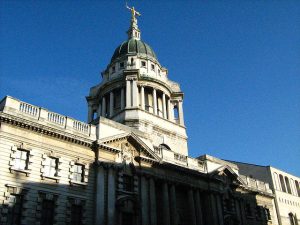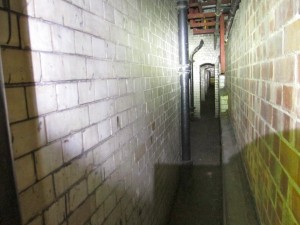The Old Bailey and past punishments
All of our first year law undergrads took part in an exercise in week one of their LLB where they escaped City and went to visit a number of buildings of significance in the local area, before tackling some research questions.
They were then asked to write a blog post inspired by their travels. 21 winners were selected from all those posts submitted – this is one of those – thanks to Anthea Thipaharan.

Credit: Pietro Ferreira on flickr
To many, the Old Bailey is just another building that stands, more than 500 years old, within the streets of London. But to others, this is where the many serious criminals that once walked among us, are tried and convicted. The ‘Yorkshire Ripper’ and the ‘Kray Twins’ are just some of the more famous criminals that were found guilty of their crimes and sent to life imprisonment.
Adorned with the words, ‘Defend the Children of the Poor and Punish the Wrongdoer’ on the magnificent buildings’ exterior, the Old Bailey holds a significant amount of history dating back to the 16th Century. It has seen countless law changes, modifications of punishment and had ‘Newgate Prison’ right on-site.
During trial proceedings, the jury and judge would hear both sides of the defendants’ case, however the defendant would be put at a disadvantage as many would not have any legal assistance and would have to sort out their own cases whilst in prison. With no knowledge of the evidence found against them or copies of the depositions, they would have to act on their feet when a witness or victim gave a testimony. Whilst in court, it was more of a way for the victim to face the perpetrator head on and ask their questions and the defendant would be expected to explain away all the evidence that was found against them. The jury, especially, had a lot more power than they do now and were allowed to shout and hurl abuse at the defendant without a judge uttering a word.

Dead Man’s Walk – Credit: Matt Brown on Flickr
Depending on the brutality of the crimes they committed, if they were found guilty by the jury, the judge would order them to a public execution and would be escorted through a dark, stone path known as ‘Dead Man’s Walk’. They would then be lead through an open area known as the ‘Birdcage’, which is where the condemned would have their last chance to see daylight.
Hundreds would gather to pelt the convicted criminals with stones and rotten fruit, with some of the wealthier spectators being able to afford ‘window boxes’ for their pleasure. But it wasn’t until 1868, that the last public execution took place, much to the dismay of the macabre crowds.
During the time that the death penalty was still valid, countless criminals were hanged, beheaded and even stoned to death for the crimes they committed, regardless of the severity. (Some were executed for merely stealing a handkerchief) Although, not known during the time, this was called the ‘Bloody Code’ which was the term that referred to the punishable crimes of the 19th Century.
The court rooms that are now filled with high tech equipment such as laptops and flat screen TVs, was once the place where lucky members of the jury were asked to observe the skin of Dr Crippen’s dead wife. Dr Crippen, who was tried for the murder of his wife Cora in 1910, was sentenced to death and subsequently hanged in Pentonville Prison. But in more recent times, names such as ‘The Yorkshire Ripper’ is what stands out.
In 1981, Peter Sutcliffe, (nicknamed The Yorkshire Ripper) was sentenced to life imprisonment at the Old Bailey for thirteen counts of murder and seven counts of attempted murder. Several reporters described the baying crowds that fought over seats in the gallery, with some camping overnight to guarantee a place. Although public executions have stopped, hundreds still gather to view the trial of some of England’s most wanted criminals.
Regardless of the changes in Law and punishment, the public’s interest in this area has continually grown. The changes in law has given even the guiltiest defendants the ability to have a fair trial which is the central point of law – ‘innocent until proven guilty’.
